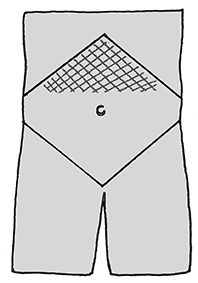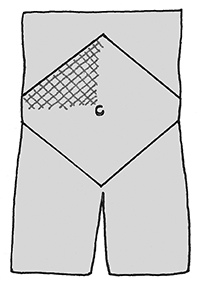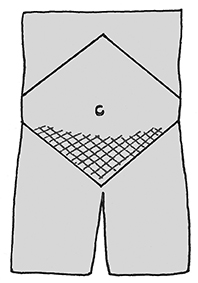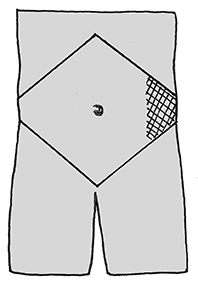Abdominal pain
- Many causes of abdominal pain can be life-threatening
- Always consider heart pain and pneumonia — these can be felt in upper abdomen
- In females always consider PID, ectopic pregnancy or miscarriage
- Give pain relief early if BP adequate. Person will be more relaxed and assessment more accurate
Abdominal assessment
Do first
- Remember Life support — DRS ABC
- For initial assessment — see Acute assessment of abdominal pain
- In females
- Always ask about contraception, last menstrual period
- Do urine pregnancy test. If negative — could still be early ectopic pregnancy or miscarriage
Ask
Pain
- Where is the pain. What area did it start
- Where does it go
- Does cough increase pain
- What does it feel like — stabbing or throbbing. Is it deep or just under the skin
- How long does it last. What makes it better/worse
- Why does the person think they have it. Have they had this pain before
Nausea, vomiting, diarrhoea
- Is vomit green (bile indicates obstruction)
- Are they passing wind. When did they last open their bowels — constipation
- Do they have diarrhoea. How often does it occur
- Is there blood in the vomit or faeces
Other Symptoms
- Fever (feeling hot and cold)
- Cough
- Chest pain
- Shoulder tip pain
- Is appetite good or bad
- Pain or burning with urination
Men
- Discharge from penis — potential STI
- Painful/tender testicles — see Testicular pain
Women
- Vaginal discharge or bleeding
- Last menstrual period, contraception
- Deep pain with sex
Past Medical History
- Abdominal operations
- Pancreatitis
- Ectopic pregnancies
- Heart problems
- High BP
- Kidney stones
- Gallstones
- History of trauma
Medications
- Pain killers, especially NSAIDS
- Other medicines
Alcohol and other drugs
- How much do they normally drink, when did they last have a drink, how much did they drink
- Smoking
- Other drugs
Look
- Pallor — pale lips, tongue, inner eyelids
- Jaundice — yellow eyes or skin
- Rash — consider shingles
- Bruising, other signs of injury
- Masses (lumps)
- Distended abdomen (abdomen swollen), rigid, or moving with breathing
Listen with stethoscope
- Centre of abdomen for bowel sounds
- May be more than usual, less than usual, none
- Are they loud, splashing, tinkling like water in a cave — consider obstruction
- Chest for crackles, wheezing, bronchial (harsh breath sounds) — consider pneumonia
Feel
- Percuss and Palpate
- Start as far from painful area as possible — get more information if you palpate and percuss most painful area last
- Gently feel all areas of abdomen, including sides and behind kidneys for tenderness, hardness, organ enlargement, masses
- Watch person’s face
- Abdomen soft or hard like wood — rigid, guarding OR very tender
- Does it hurt more in one part of the abdomen
- Does feeling or tapping in one part cause pain in another part of abdomen
- Check for tenderness or sharp pain when percuss — you tap your finger over painful area — percussion tenderness
- Check for rebound tenderness — tell person what you are going to do
- Press gently on sore area for 15 seconds, take hand away suddenly
- Watch person’s face for pain when you take hand away
- Check hernias — groin for swellings. Are they hard, soft or tender
- Hard, tender hernias are strangulated — urgent medical consult
- Check genitals (private parts) for males
- Swollen scrotum — hernia, hydrocele, cancer
- Tenderness — orchitis, epididymitis (infected testes or cord), torsion (twisted testicle)
Check
- Calculate age-appropriate REWS
- Adult — AVPU, RR, O2 sats, pulse, BP, Temp
- Child (less than 13 years) — AVPU, respiratory distress, RR, O2 sats, pulse, central capillary refill time, Temp
- Weight, BGL
- U/A, pregnancy test
- If upper abdominal pain, right upper quadrant, or chest pain — do ECG
- Repeat ECG after 30–60 minutes to see if pattern changes
Do
- Based on history and physical assessment consider possible cause of pain
- See following pages for more information about common causes
Mild pain
- Mild abdominal pain may not need hospitalisation if a cause is identifiable and pain settles with analgesia — see pain relief
Moderate-severe pain
- If person has
- REWS 3 or more in children OR 5 or more in adults
- Pain not responding to analgesia (pain relief)
- Appears very unwell
- Medical consult
- Keep nil by mouth
- Insert IV cannula
- POC Tests — electrolytes, Hb, WBC
- Take blood cultures before giving antibiotics
- IV antibiotics if infection/sepsis suspected
- Give adequate pain relief
- Consider IV fluids
- Consider oxygen
- Consider antiemetic for nausea and vomiting
- Consider urinary catheter
Upper abdominal or epigastric pain

- Usually caused by irritation of stomach or oesophagus — gastritis, reflux, indigestion
- Can be gastric/peptic ulcer, pancreatitis, gall bladder disease, pneumonia, heart disease
- Can be diabetic ketoacidosis. If high BGL — check ketones
- Common presentation of heart attack — do ECG, see Chest pain
Gastritis, reflux, indigestion
- May be history of gastritis, reflux or indigestion
- Loss of appetite
- Pain linked to hunger or eating certain foods
- Abdomen soft — may have mild tenderness
- Temp, pulse, RR, BP, O₂ sats usually normal
- Normal ECG
Do
- Give antacids (aluminium and magnesium salts) OR omeprazole oral — adult 20mg for 7 days AND review
- Advise person not to drink alcohol
- If pain continues for more than a few days with this treatment — medical consult about treatment and tests. Could be gastric/peptic ulcer or caused by some medicines
Right upper quadrant pain

- Usually caused by gall bladder disease — but may be heart attack pneumonia, uncomplicated gall stones or hepatitis (liver disease)
Gall bladder disease — infected and/or obstructed
- Suspect if very tender under right ribs
- If fever, pulse more than 100 beats/min, systolic BP less than 100mmHg, O2 sats less than 90%, yellow skin or eyes (jaundice), bilirubin on U/A — ascending cholangitis (infected bile duct)
- Pain — moderate or severe. Usually constant
Do
- Medical consult AND consider sepsis
- Give amoxicillin OR ampicillin IV — adult 2g, child 50mg/kg/dose up to 2g — doses — single dose
- If allergy to penicillin — medical consult for ceftriaxone IV — adult 1g, child 50mg/kg/dose up to 1g — doses — single dose
AND give gentamicin IV — doses — single dose
AND give metronidazole IV — adult 500mg, child 12.5mg/kg/dose up to 500mg — doses — single dose
Lower abdominal pain

- Many possible causes — can be hard to tell apart. Consider
- Appendicitis
- Strangulated or stuck (incarcerated) hernia
Men
- Twisted testicle
- Infected testes
Women
- PID — common serious cause of lower abdominal pain in non-pregnant women aged 15–35 years, often missed, can cause serious problems
- Ectopic pregnancy
Could also be
- UTI
- Constipation
- Diverticulitis
Appendicitis
- Right lower area pain — may start as central pain
- Usually nausea, vomiting, loss of appetite — may be absent, especially if elderly
- May have percussion tenderness, guarding, rebound tenderness
- Usually mild fever (37.8–38°C), fast pulse
If you suspect appendicitis — medical consult
Lower abdominal pain — women
Check
- Dates and results of last STI check and cervical screening
- History of UTIs, STIs, PID, ectopic pregnancy
- Childbirth, miscarriage, termination of pregnancy in last 6 weeks
- IUD
Ask
- Deep pain when having sex
- Vaginal loss — fluid, blood, colour, amount
- Leave pad in place
- If pregnant — contractions (baby pains), baby movements
Do
- If recent childbirth, miscarriage, termination of pregnancy — consider endometritis
- If less than 20 weeks pregnant — consider miscarriage, ectopic pregnancy
- If very unwell — consider ruptured ectopic pregnancy, septic abortion
- If more than 20 weeks pregnant — consider labour, preterm labour, placental abruption, intrauterine infection
Generalised abdominal pain

- 3 common causes — gastroenteritis, bowel obstruction (blocked gut), constipation
- 3 uncommon but very dangerous causes — generalised peritonitis, torn or ruptured abdominal aortic aneurysm, intestinal ischaemia
Ruptured abdominal aortic aneurysm
- Almost always fatal
- Usually elderly, history of high BP — may have known aneurysm
- Pain in central abdomen — may go through to back
- May feel pulsating mass — sometimes only after morphine has dulled pain
- Syncope (person may lose and regain consciousness)
- Person becomes very pale with fast pulse, falling BP, fast breathing
Do not
- Do not push IV fluids without medical consult — unless person becoming confused or drowsy
Do
- Give morphine for pain
- Repeat every 3 minutes until comfortable
Gastroenteritis
- Often fever, may have fast pulse, normal BP
- Often nausea and vomiting before pain starts
- Diarrhoea
- Mild/moderate crampy pain
- May have mild abdominal tenderness
Do not
- Do not assume abnormal observations are caused by dehydration
Do
Child — see Diarrhoea
Adult
- Can give pain relief
- Can give ORS
- If vomiting prevents oral intake — can give normal saline IV — 10mL/kg up to 1L
- If severe nausea — medical consult about antiemetic
- If no improvement after 2 hours
- Medical consult
- Do POC Test — venous blood gas, electrolytes
Bowel obstruction (blocked gut)
- Usually fast pulse, may be low BP
- Nausea and vomiting, often after pain starts
- Cramping pain, swollen belly
- Tender abdomen, sometimes guarding
- May have diarrhoea to start with then no faeces
- May have increased or sometimes tinkling bowel sounds
Do
- Urgent medical consult
- Give pain relief — usually morphine
- Put in nasogastric tube
- Put in IV cannula
- Run normal saline
- Give antiemetic to stop vomiting — do not give metoclopramide
Constipation
- Always looks well — no fever, normal pulse and BP
- Mild lower abdominal pain, usually crampy
- Small amount and/or hard faeces, may be some diarrhoea (overflow)
- Abdomen may be hard — with or without passing wind
- Usually little nausea or vomiting
Do
- Give dietary advice — high fibre and lots of water
- Can give bulking laxative (eg lactulose) or laxative (eg senna)
- If not better in a few days — medical follow-up
One-sided (flank/loin) pain


- Usually kidney problems. Felt in back or side between ribs and pelvis
- Consider pyelonephritis
Renal Colic (kidney stone)
- Severe unilateral (one-sided) flank pain may go into groin or testicle
- No fever. Sometimes fast pulse
- Blood in urine
- Vomiting common
- Usually no urinary symptoms
- Often past history of kidney stones
Check
- If U/A positive for blood — send urine for MC&S
Do
- Give pain relief — usually moderate or severe pain
- Give antiemetic to stop vomiting
- If no better after 6 hours OR if fever develops — urgent medical consult
- Must have FBC, UEC, renal ultrasound after first episode
- Monitor urine for stones passing